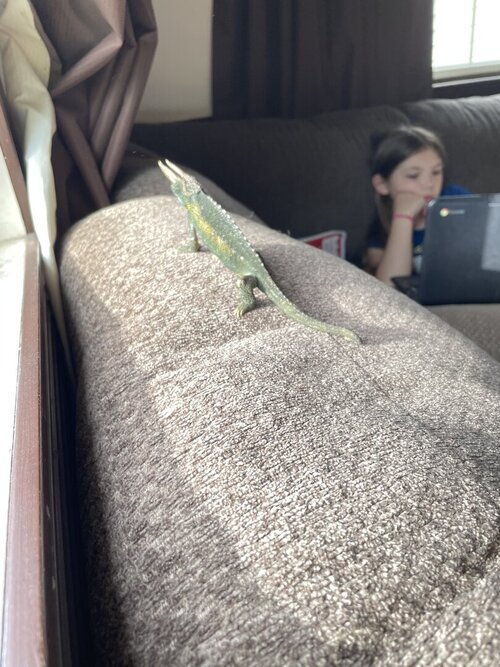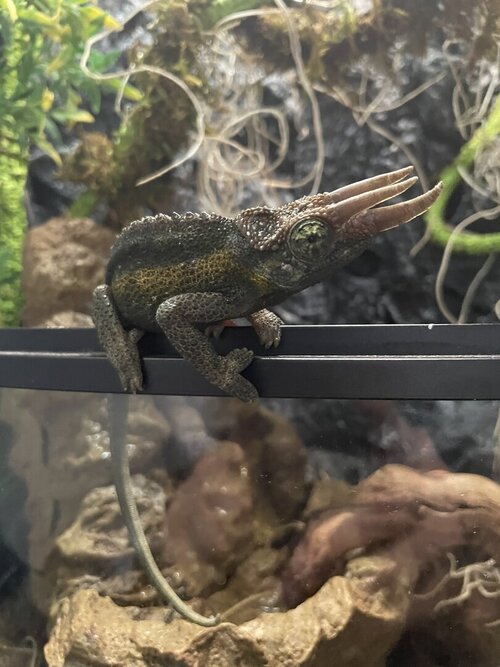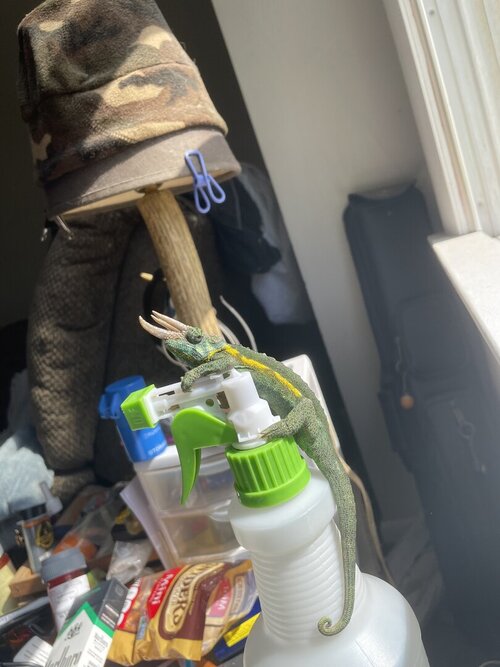I never gave much thought to having trouble getting my Jackson’s cage cold enough. But that’s where I’m at! It seems the more I study this mountainous subspecies. The lower the night temps get pushed. I hear it’s important to get in the low 60’s for proper sleep. Then I hear low 50’s is better. I have trouble getting below 70. How low and how important is it truly?
Navigation
Install the app
How to install the app on iOS
Follow along with the video below to see how to install our site as a web app on your home screen.
Note: This feature may not be available in some browsers.
More options
You are using an out of date browser. It may not display this or other websites correctly.
You should upgrade or use an alternative browser.
You should upgrade or use an alternative browser.
Jackson’s night temps!
- Thread starter Kracker
- Start date
Uri
Avid Member
From what I know as long as you are below 65 you are good. That’s what I was also told by the breeder when I had my husbandry checked. You could also listen to the chameleon academy podcast I’m pretty sure Bill strand goes deep into the temperature requirements of Jackson’s that’s where I first heard about the requirements. He doesn’t spread false information as far as I can tell probably wanna consult with more experienced keepers here thoI never gave much thought to having trouble getting my Jackson’s cage cold enough. But that’s where I’m at! It seems the more I study this mountainous subspecies. The lower the night temps get pushed. I hear it’s important to get in the low 60’s for proper sleep. Then I hear low 50’s is better. I have trouble getting below 70. How low and how important is it truly?
Klyde O'Scope
Chameleon Enthusiast
Perhaps this recent thread will help. It refers specifically to the Hawaiian Jackson's; IDK if that makes much difference or not. Bill weighed in with post #7.
Temperature drops....night time humidity....Hawaiian Jacksons chameleons...
I have some outdoors that get 50's at night and many indoors that get low to mid 60's most nights with some nights during heat waves only to 68 F. Your easiest but not cheapest solution is to get a small AC for the chams room. I use gel ice packs sometimes set on top of the cage above the sleep spot at night to get a small cooler area for them. If you are in a cooler climate open the window to that room at night. Many people have cooled down a small section of their basement.
Klyde O'Scope
Chameleon Enthusiast
Portable, mini, or room air conditioner. I would get a real air conditioner (vs. evaporative; IME, evaporative ACs don't deliver as hyped).
Where I live, the basement never gets above 65.
Where I live, the basement never gets above 65.
Klyde O'Scope
Chameleon Enthusiast
I live in a land without basements and I envy your extra square footage.
Yes I been considering a room ac unit. But I have central air and it’s just hard to swallow adding another ac. And my basement is same temp as whole house and never drops below 70. It’s just really frustrating to struggle with an extra 5-10 degree drop in temp. But I’ll get it figured out and thanks to everyone for ur input, it’s greatly appreciated.
chrisw
Established Member
I'm not new to chameleons or to this forum, but i have been away for a looong time. I am a new owner of a Mt. Meru locale Jackson's. I have a couple of other cooler weather chams but i can sympathize with Kracker. I live on the east coast and it is very hot here in summer, even at night. I can keep daytime temps in 70's and i use fans to help cool things down. My night temps are closer to 67 or 68. There is really no way to get night time temps into low 60's (short of a separate room air conditioner) and 50's are not reachable. I know that evening temps out west drop significantly at night but we are not that lucky here. I understand that these chams come from areas where night temps drop, but are there instances of longer term care where these temps can't be reached? The suggestions above are helpful and I really have nothing new to add. Just want to let Kracker know that others struggle with the recommended temps. Does anyone have input on stress colors related to heat issues? Love being back on the forum and reading all of the great input. Thanks
Thanks chrisw. And I actually have a room ac’ed for night drops but I’m just nervous letting him out all night, guess it’s a control issue LOL. I want him to have as many natural conditions as possible and for me that means complete 24hr cycles when possible. Forecast tonight calls for 51 and I usually have him in the low 60’s. And as for heat stress colors, my Jack in particular, seems to get a really pail gray color when my little guy has reached his threshold for heat. Just my humble observations.
Mendez
Chameleon Enthusiast
Woah, I think I've been summoned...
I'll read the entire thread later when I'm less busy but any chance to see a meru is definitely worth a shot.
Do you have any pics?I am a new owner of a Mt. Meru locale Jackson's
I'll read the entire thread later when I'm less busy but any chance to see a meru is definitely worth a shot.
I actually figured on that but without background I couldn’t b sure so I posted hoping for opinions that’s y I said (not sure if it’s a meru) so I definitely appreciate ur opinion after all without breeder info how we to b sure! I’d love to hear a few more positive identifications like you’re so I can b settled on where his lines start!
Mendez
Chameleon Enthusiast
Sounds good, it's always best to get multiple opinions--especially when you are unsure!
Here are some other sources to help with confirming the identification of your chameleon:
--https://www.youtube.com/watch?v=z9TvlBQjt4I
--https://chameleonacademy.com/jacksons-chameleon-care/
--https://reptifiles.com/jacksons-chameleon-care/trioceros-jacksonii-subspecies/
Here are some other sources to help with confirming the identification of your chameleon:
--https://www.youtube.com/watch?v=z9TvlBQjt4I
--https://chameleonacademy.com/jacksons-chameleon-care/
--https://reptifiles.com/jacksons-chameleon-care/trioceros-jacksonii-subspecies/
Mendez
Chameleon Enthusiast
Mt. Meru's are the smallest of the three known-to-science subspecies/species. There's evidence suggesting Mt. Meru's are not even Trioceros jacksonii merumontanus but actually Trioceros merumontanus due to being genetically different to a significant degree. And I say "known-to-science" since there are actually closer to 14+ species/subspecies of jackson's chameleons that have not been scientifically described (some of which potentially being smaller than the Mt. Merus).
The yellow-crested (j. xantholophus) is the largest in size, the machakos hills (j. jacksonii) is medium in size, and the Mt. Meru (T. j. merumontanus) is the smallest in size.
The yellow-crested (j. xantholophus) is the largest in size, the machakos hills (j. jacksonii) is medium in size, and the Mt. Meru (T. j. merumontanus) is the smallest in size.
This link shown the three species rather well.
- Resource Link - Jackson's In Captivity, by Kent Manchen
Similar threads
- Replies
- 5
- Views
- 976
- Replies
- 15
- Views
- 2K









